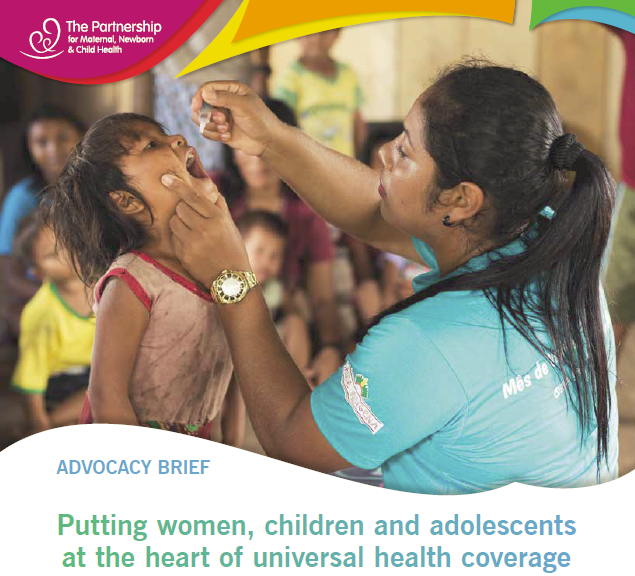Putting women, children and adolescents at the heart of universal health coverage
Women, children and adolescents account for two thirds of the world’s population, and nearly 80% in sub-Saharan Africa. Universal health coverage therefore cannot be achieved without realizing women’s, children’s and adolescents’ health. In turn, women’s, children’s and adolescents’ health cannot be achieved without realizing UHC.
The movement for universal health coverage (UHC) provides an unprecedented opportunity to accelerate progress towards ending preventable deaths and improving the health and well-being of women, children and adolescents around the world. At the same time, the UHC movement needs to recognize that in order to achieve its aims, it must prioritize the health needs of vulnerable and disadvantaged women, children and adolescents, and others left furthest behind. They are hardest hit by disease, inequities, and financial and environmental challenges – and they often have the least power and influence.
All those who support women’s, children’s and adolescents’ health (WCAH) must strive to ensure that United Nations and World Health Assembly resolutions on UHC, as well as national UHC strategies, explicitly place WCAH at the heart of UHC.
How does prioritizing women’s, children’s and adolescents’ health contribute to achieving UHC?
UHC is achieved when all people in all communities have access to the high-quality health services they need, and that using those services does not cause financial hardship. Services include health promotion, prevention, treatment, rehabilitation and palliative care.1 There is global commitment to achieving UHC through people-centred, integrated policies and programmes. A life-course approach provides an evidenceand rights-based framework to do so.2 The principle of “leaving no one behind” is central to UHC, the Sustainable Development Goals (SDGs) and the Global Strategy for Women’s, Children’s and Adolescents’ Health (2016–2030) (see Box 1).
Countries can only achieve UHC by increasing government investment in health care for the entire
population, especially at the primary health care level. Primary health care is the most cost-effective way to address most health challenges. It provides a platform for multisectoral action, integrating services, social accountability and innovations such as digital health.
Women of all ages, children and adolescents account for two thirds (66%) of the world’s population,
rising to 76% in sub-Saharan Africa.5 UHC cannot be achieved without addressing their specific needs for quality health care. Those experiencing poverty, exclusion, violence and discrimination, and those living in humanitarian and fragile settings often have the least access to quality care and financial protection. By meeting their needs, countries can make considerable progress towards achieving UHC. Women, children and adolescents have significant unmet health needs: Preventable deaths and the burden of ill health among women, children and adolescents across the life course remain unacceptably high (see Box 2). Adolescents face particular challenges in terms of access to and quality of care, as they have specific needs (including for confidentiality) and may not be reached by mechanisms aimed at children and adults.
Lack of resources and influence – often reflecting poverty, gender inequalities and other social
determinants – place women, children and adolescents at higher risk of ill health and can exacerbate
financial hardship: Large inequities in health outcomes and service coverage persist across the life course, indicating that the equity principles underpinning UHC are not being realized. Linking UHC benefits packages specifically to the health needs of vulnerable populations can help achieve gender balance and equity.
The socioeconomic benefits from investing in women’s, children’s and adolescents’ health are high: For example, an analysis of the returns from investing in reproductive, maternal, newborn and child health in 74 high-burden countries found a projected benefit–cost ratio of 8.7 to 1, based on a per capita expenditure of less than US $5.10 Another study found that improving the physical, sexual and mental health of adolescents aged 10–19 years could bring a 10-fold economic benefit.
Enabling women to plan their pregnancies through improved access to contraception increases women’s economic productivity, household income and savings, and GDP per capital. Comprehensive, integrated investments in sexual and reproductive health and rights benefit men and other genders as well.
There is a strong legal imperative to uphold the rights of women, children and adolescents to the highest attainable standard of health, as required by international law. Discrimination, abuse and violence against women, children and adolescents are among the most widespread human rights violations, and erode physical and mental health and well-being. Women’s human rights include their right to have control over and decide freely and responsibly on all matters related to their sexuality, free of coercion, discrimination and violence. Realizing these rights is essential to achieve gender equality, empower women, address inequities in access to care, and accelerate progress in preventing ill health and reducing mortality. Allocating adequate resources to improve WCAH is a central part of a rights-based approach to health financing and UHC and a concrete step towards ensuring that throughout the life course no one is left behind.
Read Putting women, children and adolescents at the heart of universal health coverage.
